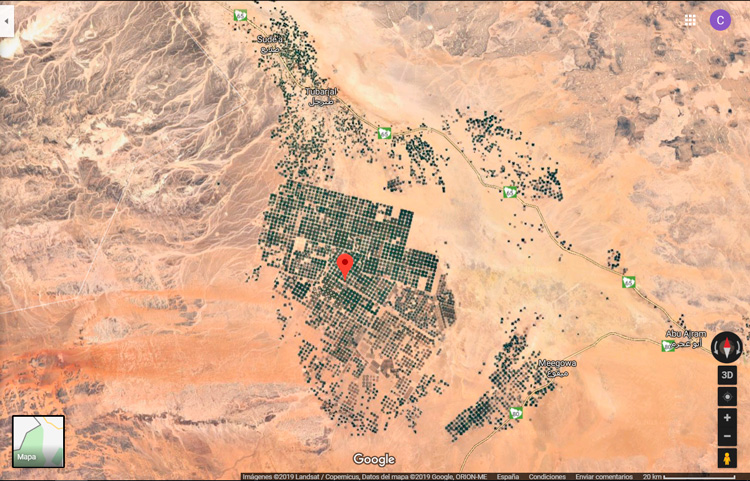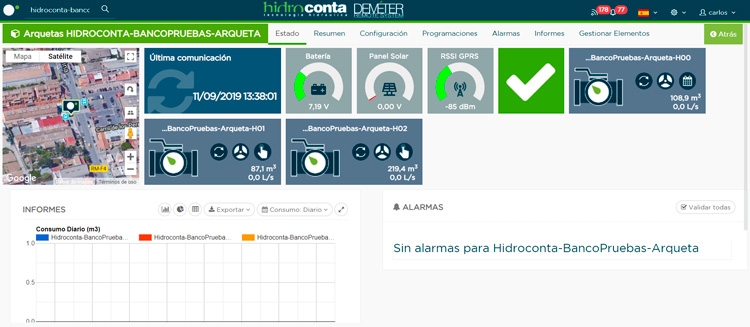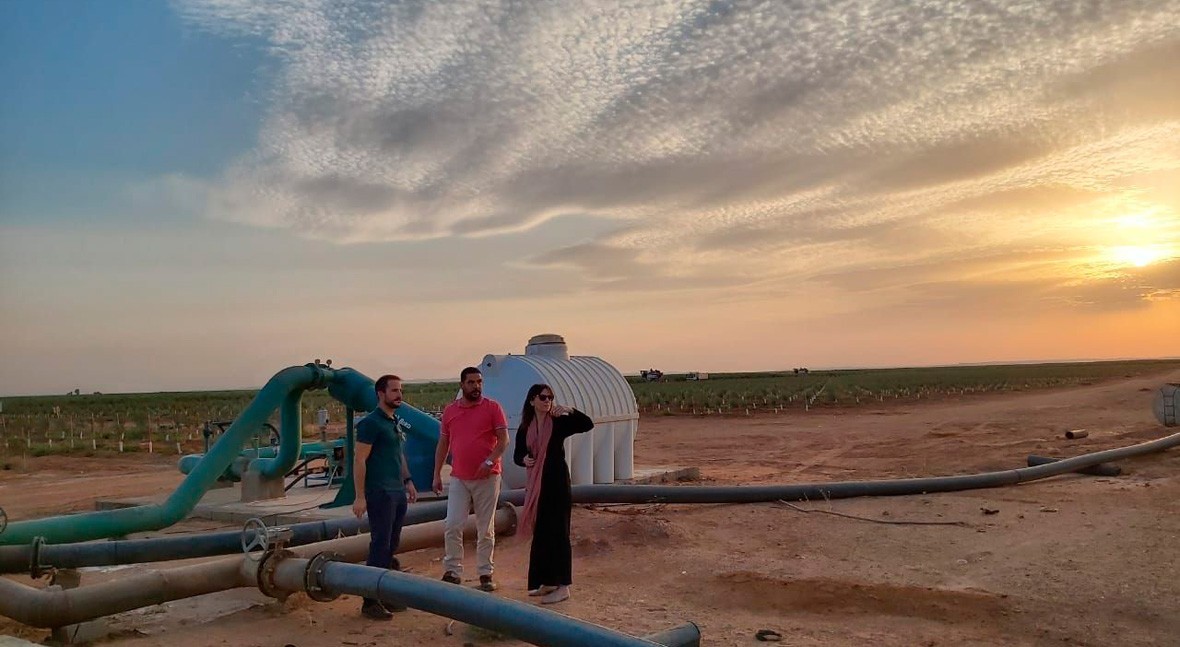Saudi Arabia monitors water withdrawal from groundwater aquifers with Spanish technology
The development of agriculture in the Saudi region of Al Jouf relies on the technological support of Hidroconta, which has provided JADCO with the necessary tools to make irrigation possible in the "Desert Kingdom".
According to MEWA, the Ministry of Environment, Water and Agriculture of Saudi Arabia, the country has enough water reserves in its groundwater aquifers for hardly sixty years, if water extraction continues at the current rate.
Hidroconta, a leading Spanish company in water technology, has developed a project to control and monitor water withdrawal from groundwater aquifers for agricultural purposes in the region of Al Jouf, with JADCO (Al Jouf Agricultural Development Company).
84% of the water available in the country is used for agricultural purposes. Of that amount, 81% comes from non-renewable groundwater aquifers, 8% from desalination, 8% from renewable aquifers, and finally, 3% from treated wastewater.
Widely known as the "Desert Kingdom", Saudi Arabia is drying up. According to UNESCO professor Radwan al-Weshah, the country suffers the worst aquifer crisis in the world, and drought threatens the main water reserves, seriously impacted.
Some causes may be noted, including fast groundwater depletion, almost null input from rainfall, and a trend towards irresponsible consumption, with an average that is twice as high as the European average per capita consumption and is even higher in high-income areas.
The development of the agri-food industry in the country is extremely difficult because of the climate conditions. However, the Saudi government supports the development of local agriculture to decrease the reliance on third-country products and become self-sufficient, even exporting certain products such as wheat.
Hidroconta has developed a project to control and monitor water withdrawal from groundwater aquifers in the region of Al Jouf
Only 2% of the country's surface area is arable land, and even with intensive irrigation and agriculture techniques, Saudi Arabia has always depended on food imports. Agriculture makes up only 2.34% of the country's GDP (2008). The main agricultural products cultivated in Saudi Arabia are dates, wheat, tomatoes, grapes, tropical and subtropical fruits, citrus fruits, potatoes, cucumbers and gherkins, melon and watermelon.
The Saudi Vision 2030 is a strategic framework to reduce Saudi Arabia's reliance on oil, diversify its economy and develop sectors like health, education, infrastructure, entertainment and tourism.
As part of Vision 2030, the government has been investing in irrigation projects to develop its arable land and respond to rapid population growth. Advanced irrigation equipment is required to successfully implement the plan, enabling optimum use of water and related products, like high-performance seeds.
In this context, Hidroconta has developed an irrigation modernisation project for the AlJouf Agricultural Development Company (JADCO), a Saudi company created in 1988. Hidroconta, with extensive experience in the modernisation of irrigated areas and the implementation of remote control systems in different countries, has developed a system with its own exclusive technology that can be adapted to the needs of any project. In this specific case, the needs of the Saudi company are quite unique given the scarce water resources in the area.
The development of the agri-food industry in Saudi Arabia is extremely difficult because of the challenging climate conditions
JADCO is located in the Busaita - Wadi Alsarhan-Aljouf district, in the northern region of Saudi Arabia. The project total surface area spans 60,000 hectares of fertile land located above fossil groundwater reserves, and the climate conditions favour the cultivation of almost any crop, like wheat, barley, corn, fodder, potatoes, onions, fruits and olive trees.
Hidroconta has supplied to this company the technology to manage remotely their irrigation systems (whether central pivot or drip irrigation systems). The company, along the lines of the country's new strategy, is adapting its crops and irrigation techniques.
The project was made possible thanks to an excellent collaborative relationship with the Alkhorayef Group, which works on agriculture and irrigation projects for large international producers. This partner is present worldwide, with operations in more than forty countries that represent products and manufacturers of known quality.
Control of water withdrawals
The scope of the project comprises the facilities of JADCO, a company located in the province of Al Jouf, in northern Saudi Arabia. The closest town is Tabarjal, at the edge of the cultivated land area. The company grows cereal using pivot irrigation and fruit trees using drip irrigation.

Location in Saudi Arabia
The water used in the agricultural operations is drawn through very deep boreholes. Water is extracted with hydraulic pumps powered by high-power, high-capacity diesel engines. Each borehole irrigates a sector, and each pivot has a diameter of approximately 800 m, therefore each pivot irrigates a surface area of more than 50 hectares.
The distances between the centre points of the pivots are approximately 1 km to the adjoining pivot and 1.47 km to the one located diagonally. Those distances represent the dispersion of the control points in the system.
Hidroconta has developed an irrigation modernisation project for the AlJouf Agricultural Development Company (JADCO), a Saudi company
The main objective of the project is to read the flow rates extracted through the boreholes and log them automatically and remotely. The project must meet the following requirements:
- Precise flow rate data logging.
- Permanent connection of remote reading equipment.
- A complete solution with a single module.
- Simple installation.
- Weathering resistance under extreme conditions: large variations in temperature in the desert, plus sand storms.
The solution provided by Hidroconta
The two issues the project must address are, on one hand, precise measurement of water flow rates and, on the other hand, remote reading, historical data log and data visualisation.
The meter converter and the Deméter telemetry terminal were set up inside a protective case to endure the harsh conditions in the desert and facilitate the installation of a single piece of equipment, connected and operational from the moment it leaves the factory.
Reading the extracted flow rates
To read the flow rates, we decided to use Hidroconta Hidromag electromagnetic flow meters, specifically the version with a separate converter and powered with 220 V AC. The energy necessary to power it will come from alternators coupled to the diesel engines already installed in the operations.
In this model, the processing is fully digital, with higher resistance to noises and producing more reliable measurements; it has the flow rate and volume data outputs necessary for the connection to the remote control system.
The working principle of the HIDROMAG electromagnetic meter is based on Faraday's Law of Magnetic Induction. The sensor consists mainly of a measuring tube with an insulation coating, a pair of electrodes inserted in the measuring tube, and a pair of coils and iron cores to produce the magnetic field. When the conductor liquid goes through the measuring tube, a voltage is produced between the electrodes, which is directly proportional to the speed of the liquid. The signal is amplified and processed by the converter to carry out the different functions shown in the display.

Cultivated area and neighbouring towns
Communication between devices and remote data visualisation
In order to enable remote data reading and historical data logging, we installed Hidroconta's Deméter System with Deméter 4H GPRS terminals.
The Deméter 4H is a remote management and monitoring device for hydrants and measuring equipment used in water consumption and distribution systems.
The installation of autonomous GPRS terminals enables controlling water extraction from aquifers; the information can be accessed from anywhere in the world through the Internet, and it is updated in real-time.
The main objective of the project is to read the flow rates extracted through the boreholes and log them automatically and remotely
Deméter terminals are fully autonomous. They are battery-powered and they can also be charged with a small solar panel. Moreover, they can communicate with a central server using GPRS technology or free band radio; they can work continuously for six months in the absence of communications with no loss of information.
Deméter 4H operates through a microcontroller that has 256 kB for firmware storage and 96 kB of volatile memory for program data. In addition, it has a 244 kB external non-volatile memory to store historical data and the configuration. That is enough to store more than 20,000 records.
The Deméter equipment has different analogue and meter inputs:
Analogue inputs: two 0-20/4-20 mA analogue inputs with 10-bit resolution. The equipment has a 15 Vdc terminal to power the probes.
Meter inputs: four-meter inputs designed for a reed type potential free contact. Consumption is 30uA with the closed contact, but they can be used as well with “open collector” pulse emitters (ensuring correct polarity).
In the Jadco installation, we used a meter input and an analogue input, thus enabling precise recording of the total volume extracted as well as instant extraction flow rates at each point in time. Furthermore, the device has outputs for latching solenoid valves, and also general-purpose digital input and output, not used in this project.
In terms of communications, the Deméter 4H has a low consumption quad-band GPRS modem (850/900/1800/1900 MHz) with a broad temperature range from -40 to 85 degrees Celsius, which is a must given de project location.
The Deméter 4H is a remote management device for hydrants and measuring equipment used in water consumption and distribution systems
The implementation of Hidroconta'a Deméter System includes a SCADA-web user interface that allows operating the equipment from any device connected to the Internet. The software allows detecting alarms, controlling quotas, generating historical data logs and managing users, through the Deméter Web application.
The Deméter Web application is a web tool to control remote units. The application can be opened from any web browser, such as a browser in a computer, a tablet or any mobile device. The system can be visualised, managed and maintained through this tool.
The interface can be accessed with a user and password.

Access to the Deméter Web platform
The software allows the registration of new users by introducing their data, user name and password, together with their level of access to the system. The administrator can decide which elements of the network can be seen or modified by each user.
Monitoring the hydraulic network is guaranteed with synoptic animated charts like the one shown.
Each system terminal is related to each Deméter remote unit installed in the network. The units can be located using the search tool or a specific code (identifier) assigned by the user and which is shown at the top of the window.
Each terminal's window has several tabs:
- Status: it shows basic information about the terminal, including whether it is active (being used) or disabled, the date and time of the last connection, the total volume of the associated meter, the number and type of equipment connected, the status of the terminal, including the GPRS model, the battery or solar panel and general reports.
- Summary: it shows the information of the connected equipment in a table format to facilitate a quick overview of the network status.
- Configuration: it shows with several drop-down menus the basic equipment configuration, including the assigned identifier, the search criteria, the battery alarm levels, the configuration of communications and the GPRS link, the alerts that have been set up with the type and predefined thresholds, or the historical data log.
- Programs: it allows access to the valve and digital output programs of the elements linked to the device.
- Alarms: if they are enabled, it shows the active alarms in the terminal.
- Reports: it allows showing in a chart or a table the historical data for the terminal and the connected elements.
- Manage elements: it allows enabling or disabling the equipment inputs and outputs, so the user can connect new equipment whenever the system undergoes modifications.















